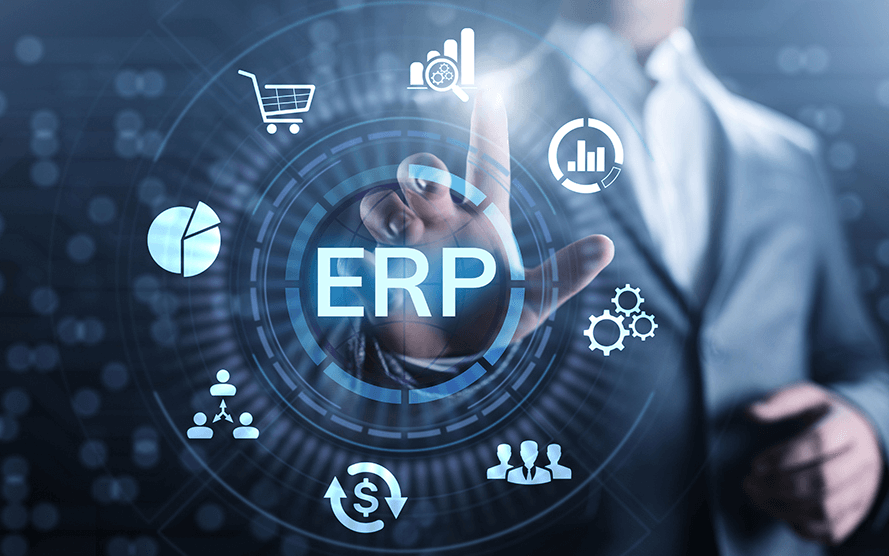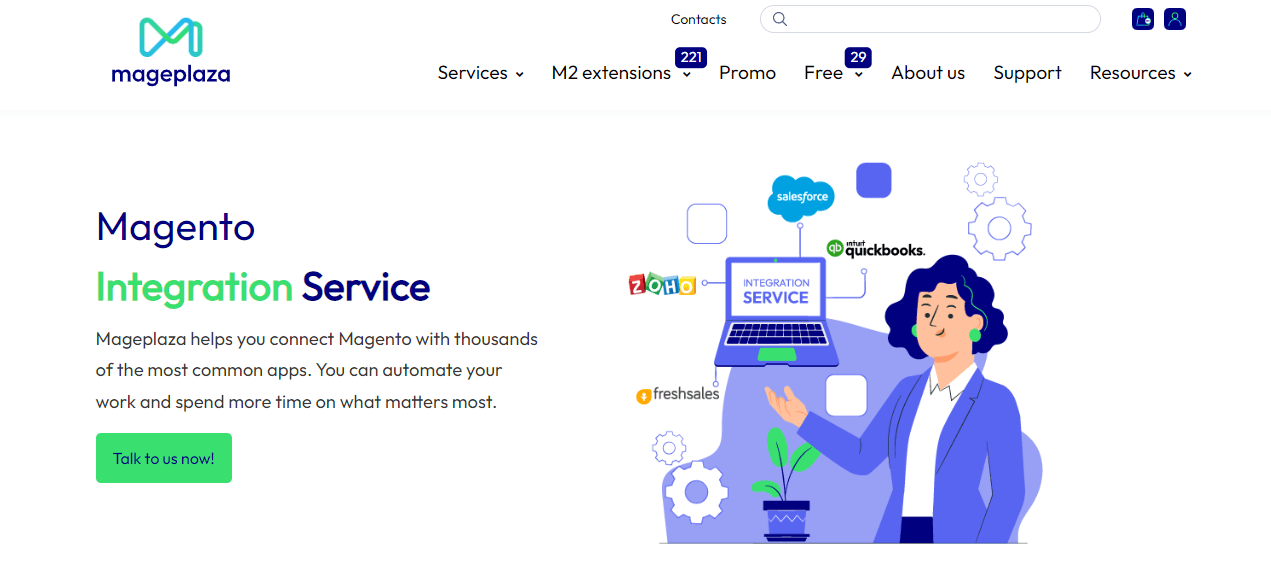10 Key Considerations When Integrating Magento With ERP
With a big catalog of 234+ extensions for your online store
Let’s start with this scenario: Your Magento store has grown past 10,000 SKUs, but you are still processing orders manually and calculating taxes in spreadsheets. Your customers might be facing stockouts and spending days waiting for their order information.
That leads to many data inaccuracies and even lost revenues. What a nightmare!
So, why not automate all these processes?
With the Magento ERP integration, you can prevent the nightmare of batch processes. It becomes easier to automatically sync your customer data, orders, inventory, and shipping details, and deliver an excellent customer experience.
However, implementing Magento ERP integration might be a big project that costs you lots of time and effort. That’s why you should craft a well-prepared plan in advance.
This guide will show you 10 key considerations before merging Magento with ERP. Let’s dive in!
Magento Integration Service
by Mageplaza
Connect Magento store with other apps instantly with experts' help
Learn moreTable of Content
- Why should you integrate Magento with ERP?
- 10 key considerations when integrating Magento with ERP
- 1. Build a careful plan and proper strategy
- 2. Define your specific requirements
- 3. Pick the most appropriate ERP software
- 4. Ensure the availability of basic functionalities
- 5. Prepare your data
- 6. Determine which data should flow between Magento and ERP
- 7. Decide how to manage your orders
- 8. Prefer the customized solution
- 9. Pay attention to your budget and timeframe
- 10. Choose a trustworthy integration service provider
- The bottom line
Why should you integrate Magento with ERP?
To know why it’s worth implementing a Magento ERP integration project, you should understand what ERP is first.
ERP (Enterprise Resource Planning) is a system that organizations use to manage daily activities, such as project management, risk management, accounting, supply chain operations, and compliance. Nowadays, ERPs are vital for managing thousands of businesses of any size and industry.

According to Adobe, after two years of the pandemic (Mar 2020 - Feb 2022), Americans spent $1.7 trillion online, with $609 billion more than in the two preceding years. It’s obvious to see the significant growth of E-commerce regardless of the pandemic damage.
The growth in digital shopping has set a new baseline, and consumer shopping habits won’t snap back to pre-pandemic ways. Thus, getting on board with E-commerce is not the only priority you need to do with your business! Once you run your Magento store, it’s essential to integrate it with ERP.
Even though the Magento ERP integration requires high standards, it undoubtedly brings many advantages to your businesses, including supply chain management and workflow automation.
Once all data is unified, visible, and accessible, you can get work done more efficiently, while running offline and online processes more smoothly.
10 key considerations when integrating Magento with ERP
Consider the following best practices to ensure that the chosen ERP system is correctly mapped with your Magento store, thus ruling out any possibility of miscommunication and misalignment.
1. Build a careful plan and proper strategy
You should clearly define your integration purposes to save time and avoid wasting your budget. Make sure you understand what your business aims to achieve from this integration project and what challenges may occur during the process.
Answer the following questions will partly help you build a clear strategy for Magento ERP integration:
- What would you like to achieve from this Magento ERP integration?
- Which points do you want to integrate between your Magento site and ERP system?
- Where is your data coming from and going?
- What is the unique and most advantageous workflow of your business?
- Do you need your data to flow both ways or one way?
- What are your expectations for the frequency of its flow?
The more questions you ask and answer, the clearer your integration plan is.
2. Define your specific requirements
After identifying the blueprint and challenges of your integration project, you need to create a detailed description of every requirement.
Unless you know and understand the integration complexity, it’s easy to underestimate the project requirements. So, it’s critical to set specific goals and have a clear definition of “done” for all your requirements.

Based on your specific requirements in the integration project, you should consider the following:
- Timing - the time required for accomplishing deliverables and the best possible completion date.
- Budget - the amount of money your business can invest in the integration project.
- Quality - the accepted level of performance when compared to your requirements and expectations.
3. Pick the most appropriate ERP software
It’s a fact that the market is now flooded with ERP platforms, and choosing the right solution for your business can be daunting.
Firstly, it’s vital to understand what ERP type you need to achieve your business goals. There are industry-specific on-premise ERP and cloud-based ERP solutions available from which you can select, depending on your budget and technical limitations.
Secondly, you must evaluate whether the ERP’s underlying mechanisms align with the business model of your Magento store. It’s worth remembering that an ERP for the manufacturing industry differs from an ERP for the retail industry. You should perform a gap analysis to locate your specific requirements and explore ERP software catering to your needs.
For instance, an ERP solution for E-commerce platforms should possess omnichannel capabilities to control different customer touchpoints. It should be flexible to manage multiple warehouses in real-time, control orders, support CRM (Customer Relationship Management), and offer EDI (Electronic data interchange) capabilities for data to flow smoothly.
Of course, some common ERP solutions are widely used among Magento merchants, including:
-
Odoo. Odoo is one of the leading open-source ERP platforms, which is previously known as OpenERP. Odoo features include an extensive number of business apps for different requirements and industries. Businesses only pay for the apps that they need.
-
Microsoft Dynamics. This platform offers mission-critical business functions, like human resources, finance, and operations management. It also props up processes associated with E-commerce, such as shipping, fulfillment management, and stock database integration.
-
Sage. As a global company, Sage provides various ERP and accounting solutions used by both B2C and B2B clients. Each offers a single solution for managing your business processes, including sales, inventory, finances, customer service, etc.
-
NetSuite. NetSuite is a cloud-based ERP platform and business intelligence solution for medium-sized organizations. It supports multiple E-commerce functions, including product and customer data sharing and queueing. It’s also popular due to the open-source Magento integration connector, allowing developers to customize and fit their needs.
4. Ensure the availability of basic functionalities
Not every feature is relevant to your business needs. But the basic features, such as stock management, order management, customer relationship management, finance and accounting management, distribution, and shipping management, must appear as a prerequisite.
Besides, you should look for business intelligence features. Even though ERP platforms are known as functional workhorses, they possess much higher potential thanks to data collection capabilities. You can mine ERP data flows to create long-term forecasts and coordinate essential organizational moves.
The chosen ERP system must resonate with the critical components of your Magento store and generate synergies on pairing. The best part of Magento is that its framework is perfectly compatible and can be well integrated with almost any ERP solution.
5. Prepare your data
Preparing the database will decrease the complexity of your Magento ERP integration project. It’ll also save you time and money.

So, what should you do to prepare data?
- File up all data types, like text, number, data, etc., both in the Magento and ERP systems.
- Clean your database by purging the duplicates, abundant index, and records and rectifying inaccurate figures.
- Create a backup for your Magento store; it’ll be used at the time of integration.
- Address compliance and security issues in advance if you have sensitive data that need to be secured.
6. Determine which data should flow between Magento and ERP
It becomes vital to decide which data should be passed back and forth between your Magento store and the ERP system. The following points are worth your consideration:
- Should the integration be a two-way data stream or just a one-way process?
- What data types need to be used in this integration? Should it include customer data, product details, price, or something else?
- How often does the data need to flow between Magento and ERP? Once every 15 minutes or once per work day?
Data that should flow between two platforms often include customer, inventory, product, order, and shipment data. In any circumstance, it’ll most likely be necessary to create a compromise based on your needs and budget.
7. Decide how to manage your orders
While integrating Magento with ERP, you’ll have multiple inventory management configuration options. They give the opportunity to import/export orders through one single channel and develop various separate pathways for orders received online.
8. Prefer the customized solution
There are two main methods you can take in any Magento ERP integration. The first one is to choose a pre-built connector like the ones offered by eBridge Connections, Modern Retail, or Logic Broker. The second option is to build a custom connection from the ground up.
With the custom option, you’ll get mission-critical features while eliminating the unnecessary ones within your budgetary stipulations, which are not available if you choose a pre-built connector.
So, it’s recommended to choose a customized solution to yield higher efficiencies.
9. Pay attention to your budget and timeframe
It’s vital to consider your budget and timeframe. The Magento ERP integration is influenced by the type of integration, which can be completely automated or manual to a degree (semi-manual). It’s also affected by the number of touchpoints, which come in the form of bi-directional or one-way points.
Both factors will dramatically impact the required time and cost for the project completion. That’s why Magento integration with ERP can take several weeks to months.
10. Choose a trustworthy integration service provider
Your team may be successfully handling the Magento platform, but connecting it with a massive solution like ERP can take time and effort. So, instead of doing it yourself, it’s always advisable to have experts implement this task.
The integration task is best left to specialists that understand two platforms inside and out, and know how to overcome risks. Fortunately, even if you’re a startup, SMB, or large enterprise, it’s not hard to find an integration partner that fits your needs.
Your quest to seek a credible service provider for Magento ERP integration can successfully end at Mageplaza. In addition to well-coded, fully-featured extensions, we offer a number of dedicated and sustainable services to help your Magento 2 business reach the next level.

So, why should you choose us for your Magento ERP integration project?
-
Dedicated integration specialists. For the last decade, we’ve been delivering a number of Magento 2 integrations. With the help of Mageplaza’s certified and experienced developers, our clients have successfully transferred data between Magento and other platforms.
-
Best industry practices. We always follow the best practices in implementing the integration to help you leverage your store’s full capabilities.
-
Free post-release support. Our top-rated support team will answer all relevant questions even after two months. We want to make sure that everything runs smoothly and that you’re satisfied with the result.
-
Affordable cost. All our Magento services are budget-friendly, so don’t worry about the price. You should contact us for a free consultation from our experts and get a quote for your project.
-
Transparent process. It’s possible to track relevant statuses and change the integration scope if needed.
CONTACT OUR INTEGRATION SPECIALISTS NOW
The bottom line
Integration is a rather complicated process and requires careful planning. The key here is to understand the elements of ERP and Magento, then make sound business decisions.
With proper planning and implementation, your ERP integration project will be less complex. There might be challenges during the process, but if you stick to your business goals and have the right solution partner, it’ll become easier to accomplish the project.
If you have any questions or concerns about integrating Magento with ERP, contact us now for more help!
& Maintenance Services
Make sure your M2 store is not only in good shape but also thriving with a professional team yet at an affordable price.
Get StartedNew Posts

May 2023
Stay in the know
Get special offers on the latest news from Mageplaza.
Earn $10 in reward now!








